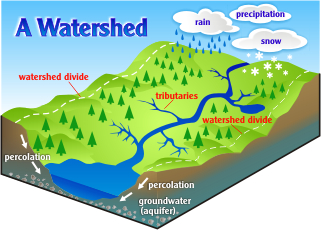SOURCE WATER
What is a Watershed?
A watershed is an area of land that drains water into a stream or other body of water. Watersheds exist at many different scales and are named for the draining water feature. The New River Watershed, for example, includes all of the land surfaces and streams over which water eventually flows to the New River.
Watershed conditions can directly affect the quantity and quality of source water supplies. Water travels over the land’s surface – farm fields, forests, lawns and city streets – on its course to a waterway. The water is impacted by what happens in the watershed.
The climate and amount of precipitation determine how much water is available and the lay of the land controls how water and other materials move through the watershed. The type of land use and development often relates to quality because certain contaminants can be associated with specific land uses. Understanding local water conditions is an important component of source water assessment and protection.
For more information about watersheds and watershed management, visit the USEPA’s Watershed Academy at: http://www2.epa.gov/watershedacademy.
For more information about the watershed for your drinking water source, click here.

Potential Sources of Contamination
Various potential sources of contamination or pollution can exist within watersheds. These can be from either natural sources such as minerals that leach out of soil and rock, or man-made sources such as manufactured chemicals or waste materials. Contaminants can enter water supplies by direct runoff, contributing flow from smaller streams, and/or infiltration into the ground.
Contaminant sources are often grouped into one of two broad categories: point sources and non-point sources. Point source pollution occurs at a specific identifiable location, such as discharge from a pipe or a leaking aboveground or underground storage tank. Non-point source pollution (NPS) occurs across a broader area that cannot be tied to a specific point. Examples of non-point source pollution include excess fertilizers and pesticides from agricultural and residential areas, waste and toxic chemicals from urban stormwater runoff, and sediment from erosion.
Each watershed is unique and can contain different types of contaminant sources depending on land use. Source water assessments evaluate local conditions and support development of strategies to manage risk to sources of supply for drinking water.
For more information about pollutants and management strategies, visit the USEPA’s Water Pollution Prevention & Control site at: http://water.epa.gov/polwaste/.

